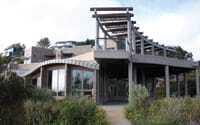In 2009, the median price of an existing single-family home in the United States declined by 12.5 percent, the largest single-year drop since the National Association of Realtors began tracking the number in the late 1960s. But there were pockets of stable values and even rising home prices in every major metropolitan area across the country. The location of these stronger neighborhoods tended to depend on the traditional strengths of the metropolitan area as a whole.
In metropolitan areas known for having vibrant downtowns and urban centers—places like Chicago, Portland, and Washington, D.C.—neighborhood districts in attractive sections of the city or in desirable close-in suburbs tended to hold their home values better than other districts did during 2009 and early 2010. On the other hand, in metropolitan areas known more for suburban sprawl—places like San Diego and Kansas City, Missouri—the neighborhoods that held their values better typically were in newer, outer suburban sections.
In metropolitan areas exhibiting these patterns, neighborhood districts with the best housing appreciation exhibited several common characteristics. The strongest closer-in areas, whether urban or inner suburban, tended to offer a combination of housing styles in popular, mixed-use residential districts near job centers and shopping—reinforcing the growing demand for charming, vibrant, walkable neighborhoods. Meanwhile, the pockets of value appreciation in outer suburban areas combined the characteristics of good schools and newer housing, plus proximity to special amenities such as a body of water.
Since the housing bubble began to burst in the mid-2000s, a general perception has existed nationally that urban city neighborhoods have held their home values better than suburban sections. As Jed Smith, managing director of research at the National Association of Realtors, put it, “My impression is the biggest gains have been closest to the center of the city.”
While that certainly holds true for some city neighborhoods, for many others it does not. The national reality is full of variation. What has happened with prices across metropolitan Washington, D.C., is different from the experience in metropolitan Nashville, which is different from the experience in San Diego, and so on. In fact, there appears to be no clear trend in housing appreciation within metropolitan areas in 2009 and early 2010. “There’s a lot of variety in the trends and not a lot of clarity in an overall sense,” says William H. Lucy, a University of Virginia planning professor whose book Foreclosing the Dream: How America’s Housing Crisis Is Changing Our Cities and Suburbs was published this year.
To analyze recent price trends, housing prices by ZIP code—the smallest geographic area for which price data are typically available—were examined in more than a dozen metropolitan areas. Sales prices—either median or average, either all sales or resales, depending on the metropolitan area—were compared from 2009/early 2010 to a year earlier. The data were based either on final sales recorded in a metropolitan area’s multiple listing service or on property transactions recorded at county assessor or recorder offices.
For many of the nation’s larger metropolitan areas, housing prices hit bottom in 2009. The declines in median resale prices last year included 28 percent in Phoenix, 26 percent in Miami, 17 percent in Atlanta, 13 percent in Portland, Oregon, and 10 percent in the Washington, D.C., area. Nevertheless, every metropolitan area had pockets of housing appreciation, bucking the overall downward trend.
Two opposing views exist on where those pockets are typically located. On one side, housing experts at Zillow, an online housing research firm, found that in the nation’s top ten metro areas, home values have generally held up better the closer a home is to the city center. “Depreciation grows in a linear pattern from the center of the city, so outlying areas experience the highest total declines,” says Stan Humphries, Zillow’s chief economist. Yet, even he acknowledges the pattern is not uniform.
On the opposite side, some metropolitan researchers, including Joel Kotkin, an economic development consultant whose latest book, The Next Hundred Million: America in 2050, was published this year, found that in many larger metropolitan areas outside the top ten, home prices tended to hold up better in the suburbs. “The notion that suburbs, even exurbs, were particularly hard hit is based largely on wishful thinking,” Kotkin says.
Metro areas researched and analyzed for this article exhibited both of these trends.
Downtown resilience. In both metropolitan Portland and Nashville, housing prices in nearly all suburbs continued trending downward in 2009, but some neighborhoods in and around the downtowns showed consistent strength, according to MDA DataQuick, which collects sales prices from counties in selected metro areas.
Median housing prices in Nashville’s 37203 ZIP code, encompassing a mixture of bungalows and high-rise condominiums between the center of downtown and Vanderbilt University, continued rising slightly during the second half of 2009 and during the first quarter of 2010—one of only three metropolitan Nashville ZIP codes to do that. The same was the case with Portland’s 97214, an area on the eastern edge of downtown with a mixture of 100-year-old Victorian homes and modernist low-rise condominium buildings.
Other downtown areas in these cities were not so fortunate. The median price in Portland’s Pearl District plunged 25 percent during the first quarter from a year earlier, attributable in part to distressed sales. But even a series of condo foreclosure sales in Nashville’s 37203 did not drag down that neighborhood’s market values. “Hospitals and research centers around the universities are a growth industry in Nashville, and doctors want to live near there,” says Lucy S. Smith, president of the Greater Nashville Association of Realtors.
Inner-ring appeal. In many of the largest U.S. metro areas, most parts of the inner cities and outer suburbs continued suffering double-digit drops in home prices last year and the beginning of this year. But some attractive pockets within the core cities and closer-in suburbs were among the first areas to experience a revival in prices.
In Chicago, it was the North Side’s Gold Coast ZIP codes along the Lake Michigan lakefront that saw prices rise. Neighborhoods such as Uptown and Wrigleyville in 60613, offering a mixture of five-story walkups, high rises and narrow- lot homes, experienced a 13 percent increase in median sales price during the first quarter of this year, according to DataQuick.
Reston, Virginia |
In the Washington, D.C., area, the attractive pockets were in close-in suburbs such as Reston and Vienna in Fairfax County, Virginia. Both places are known as walkable communities—Reston with an internationally known town center and Vienna with a smalltown downtown strip. Reston’s median home prices have returned to 2007 levels and Vienna’s to early-2008 levels, according to the Zillow Home Value Index, which measures median home values adjusted for changes in the mix of homes sold.
“The general trend is, the closer to the District [of Columbia], the better the price appreciation. There’s more demand,” says Vinh Nguyen, board chairman of the Northern Virginia Association of Realtors.
Suburban strongholds. Suburban living dominates most major metropolitan areas across the United States, but housing values remain on a downward slide in much of suburbia. Where pockets of appreciation have occurred, they have tended to be on the outskirts in places where the school districts are prized.
In the Kansas City metro area, according to the regional association of Realtors there, average resale prices rose slightly between 2007 and 2009 in only 15 percent of metro ZIP codes. One such area was downtown; the rest were on the edges of the metro area, such as 64081 in Lee’s Summit, Missouri, and 66223 in Overland Park, Kansas, both of which have desirable school districts, nearby lakes, and homes built during the past decade with gabled garages as a primary architectural element. “Areas that are newer, that’s where buyers are drawn to,” says Renee Ryan-Edwards, broker/manager for Reece & Nichols Lakewood in Lee’s Summit.
Cardiff-by-the-Sea |
Halfway across the country in San Diego, the situation was basically the same. Average resale prices rose slightly between 2008 and 2009 in just 9 percent of metropolitan ZIP codes tracked by DataQuick. Again, only one was in the central part of the city; the rest were on the suburban fringes, such as 92007 in Cardiff-by-the-Sea, with its boxy, compact two-story homes along the north coast, and 92029 in western Escondido, with its larger lots and lake views. Home values in both areas had dropped, along with those in the rest of California, before starting to recover.
“When communities that are popular get affordable, then the demand increases, too,” says Mark Marquez, president of the San Diego Association of Realtors.
U.S. home prices are not expected to begin a widespread recovery until 2011, according to a recent survey of 100 economists and housing analysts by securities firm MacroMarkets. So far, the rebound has generally occurred in pockets of popular, attractive, walkable neighborhoods in some urban or inner-suburban locales, along with some pockets of outer suburbia featuring newer homes, sought-after schools, and special amenities. But the emergence of these pockets tends to vary widely by metropolitan area.



